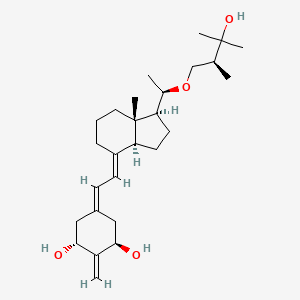
Warfarina
Descripción general
Descripción
La warfarina es un anticoagulante conocido que se utiliza para prevenir y tratar los coágulos de sangre. Se prescribe comúnmente a personas con riesgo de desarrollar coágulos de sangre dañinos, como las que tienen fibrilación auricular, trombosis venosa profunda o embolia pulmonar . La this compound funciona inhibiendo la síntesis de los factores de coagulación dependientes de la vitamina K, lo que reduce la capacidad de la sangre para coagular .
Mecanismo De Acción
La warfarina ejerce sus efectos anticoagulantes inhibiendo la enzima vitamina K epóxido reductasa . Esta enzima es responsable de convertir el epóxido de vitamina K de regreso a su forma activa, hidroquinona de vitamina K. Al bloquear esta conversión, la this compound reduce los niveles de vitamina K activa, lo que lleva a una disminución de la síntesis de los factores de coagulación dependientes de la vitamina K (II, VII, IX y X) . Esto da como resultado una capacidad de coagulación sanguínea reducida.
Aplicaciones Científicas De Investigación
La warfarina tiene una amplia gama de aplicaciones de investigación científica:
Análisis Bioquímico
Biochemical Properties
Warfarin’s biotransformation is a complex process involving over nine different metabolites . It interacts with cytochrome P450 2C (Cyp2c) enzymes, which are instrumental in the biotransformation of Warfarin to its 7-hydroxylated metabolite .
Cellular Effects
Warfarin alters vitamin K metabolism, which has significant consequences as vitamin K-dependent (VKD) proteins function in numerous physiologies in many tissues . These proteins may be poorly carboxylated and dysfunctional if the second activity is not ubiquitously expressed similar to VKORC1 .
Molecular Mechanism
Warfarin inhibits the vitamin K oxidoreductase (VKORC1), which generates vitamin K hydroquinone (KH 2) required for the carboxylation and consequent activation of VKD proteins . Warfarin uncouples the 2 reactions that fully reduce KO .
Temporal Effects in Laboratory Settings
It is known that Warfarin’s metabolism involves a rate-limiting step in the biotransformation of Warfarin to its 7-hydroxylated metabolite .
Dosage Effects in Animal Models
It is known that Warfarin’s metabolism is a complex process involving over nine different metabolites .
Metabolic Pathways
Warfarin is involved in the metabolic pathway of vitamin K. It inhibits VKORC1, which generates KH 2 required for the carboxylation and consequent activation of VKD proteins .
Transport and Distribution
It is known that Warfarin interacts with Cyp2c enzymes during its metabolism .
Subcellular Localization
Warfarin and VKORC1 both reside in the endoplasmic reticulum and mediate VKD protein modification during secretion
Métodos De Preparación
Rutas de Síntesis y Condiciones de Reacción
La warfarina se puede sintetizar a través de varios métodos. Una ruta de síntesis común implica la condensación de 4-hidroxicumarina con bencilidenacetona en condiciones básicas . La reacción normalmente utiliza hidróxido de sodio como base y etanol como disolvente. El producto se purifica mediante recristalización.
Métodos de Producción Industrial
La producción industrial de this compound implica la síntesis a gran escala utilizando métodos similares a los utilizados en los entornos de laboratorio. El proceso está optimizado para el rendimiento y la pureza, a menudo involucrando reactores de flujo continuo y técnicas de purificación avanzadas . El producto final se formula en tabletas o soluciones inyectables para uso médico.
Análisis De Reacciones Químicas
Tipos de Reacciones
La warfarina experimenta diversas reacciones químicas, incluidas reacciones de oxidación, reducción y sustitución .
Reactivos y Condiciones Comunes
Oxidación: La this compound se puede oxidar utilizando reactivos como permanganato de potasio o peróxido de hidrógeno en condiciones ácidas.
Reducción: La reducción de this compound se puede lograr utilizando agentes reductores como borohidruro de sodio o hidruro de litio y aluminio.
Productos Principales
Los productos principales formados a partir de estas reacciones dependen de los reactivos y condiciones específicas utilizados. Por ejemplo, la oxidación de la this compound puede conducir a la formación de quinonas, mientras que la reducción puede producir derivados hidroxilados .
Comparación Con Compuestos Similares
La warfarina a menudo se compara con otros anticoagulantes, en particular los anticoagulantes orales directos (AOD) como apixaban, dabigatrán y rivaroxabán . A diferencia de la this compound, que inhibe los factores de coagulación dependientes de la vitamina K, los AOD inhiben directamente factores de coagulación específicos (por ejemplo, factor Xa o trombina) . Esta diferencia en el mecanismo hace que los AOD actúen más rápido y sean menos dependientes de los factores dietéticos, pero también pueden tener diferentes perfiles de efectos secundarios .
Compuestos Similares
Apixaban: Inhibidor directo del factor Xa.
Dabigatrán: Inhibidor directo de la trombina.
Rivaroxabán: Inhibidor directo del factor Xa.
La this compound sigue siendo única debido a su larga historia de uso, protocolos de monitoreo bien establecidos y su papel en pacientes con condiciones específicas donde los AOD pueden no ser adecuados .
Propiedades
IUPAC Name |
4-hydroxy-3-(3-oxo-1-phenylbutyl)chromen-2-one | |
|---|---|---|
| Source | PubChem | |
| URL | https://pubchem.ncbi.nlm.nih.gov | |
| Description | Data deposited in or computed by PubChem | |
InChI |
InChI=1S/C19H16O4/c1-12(20)11-15(13-7-3-2-4-8-13)17-18(21)14-9-5-6-10-16(14)23-19(17)22/h2-10,15,21H,11H2,1H3 | |
| Source | PubChem | |
| URL | https://pubchem.ncbi.nlm.nih.gov | |
| Description | Data deposited in or computed by PubChem | |
InChI Key |
PJVWKTKQMONHTI-UHFFFAOYSA-N | |
| Source | PubChem | |
| URL | https://pubchem.ncbi.nlm.nih.gov | |
| Description | Data deposited in or computed by PubChem | |
Canonical SMILES |
CC(=O)CC(C1=CC=CC=C1)C2=C(C3=CC=CC=C3OC2=O)O | |
| Source | PubChem | |
| URL | https://pubchem.ncbi.nlm.nih.gov | |
| Description | Data deposited in or computed by PubChem | |
Molecular Formula |
C19H16O4 | |
| Record name | WARFARIN | |
| Source | CAMEO Chemicals | |
| URL | https://cameochemicals.noaa.gov/chemical/5240 | |
| Description | CAMEO Chemicals is a chemical database designed for people who are involved in hazardous material incident response and planning. CAMEO Chemicals contains a library with thousands of datasheets containing response-related information and recommendations for hazardous materials that are commonly transported, used, or stored in the United States. CAMEO Chemicals was developed by the National Oceanic and Atmospheric Administration's Office of Response and Restoration in partnership with the Environmental Protection Agency's Office of Emergency Management. | |
| Explanation | CAMEO Chemicals and all other CAMEO products are available at no charge to those organizations and individuals (recipients) responsible for the safe handling of chemicals. However, some of the chemical data itself is subject to the copyright restrictions of the companies or organizations that provided the data. | |
| Record name | WARFARIN | |
| Source | ILO-WHO International Chemical Safety Cards (ICSCs) | |
| URL | https://www.ilo.org/dyn/icsc/showcard.display?p_version=2&p_card_id=0821 | |
| Description | The International Chemical Safety Cards (ICSCs) are data sheets intended to provide essential safety and health information on chemicals in a clear and concise way. The primary aim of the Cards is to promote the safe use of chemicals in the workplace. | |
| Explanation | Creative Commons CC BY 4.0 | |
| Source | PubChem | |
| URL | https://pubchem.ncbi.nlm.nih.gov | |
| Description | Data deposited in or computed by PubChem | |
DSSTOX Substance ID |
DTXSID5023742 | |
| Record name | Warfarin | |
| Source | EPA DSSTox | |
| URL | https://comptox.epa.gov/dashboard/DTXSID5023742 | |
| Description | DSSTox provides a high quality public chemistry resource for supporting improved predictive toxicology. | |
Molecular Weight |
308.3 g/mol | |
| Source | PubChem | |
| URL | https://pubchem.ncbi.nlm.nih.gov | |
| Description | Data deposited in or computed by PubChem | |
Physical Description |
Warfarin is an odorless and colorless solid. Used as a rodenticide for Norway rats and for house mice. (EPA, 1998), Colorless, odorless, crystalline powder. [rodenticide]; [NIOSH], Solid, COLOURLESS-TO-WHITE POWDER., Colorless, odorless, crystalline powder or solid., Colorless, odorless, crystalline powder. [Note: Rodenticide.] | |
| Record name | WARFARIN | |
| Source | CAMEO Chemicals | |
| URL | https://cameochemicals.noaa.gov/chemical/5240 | |
| Description | CAMEO Chemicals is a chemical database designed for people who are involved in hazardous material incident response and planning. CAMEO Chemicals contains a library with thousands of datasheets containing response-related information and recommendations for hazardous materials that are commonly transported, used, or stored in the United States. CAMEO Chemicals was developed by the National Oceanic and Atmospheric Administration's Office of Response and Restoration in partnership with the Environmental Protection Agency's Office of Emergency Management. | |
| Explanation | CAMEO Chemicals and all other CAMEO products are available at no charge to those organizations and individuals (recipients) responsible for the safe handling of chemicals. However, some of the chemical data itself is subject to the copyright restrictions of the companies or organizations that provided the data. | |
| Record name | Warfarin | |
| Source | Haz-Map, Information on Hazardous Chemicals and Occupational Diseases | |
| URL | https://haz-map.com/Agents/673 | |
| Description | Haz-Map® is an occupational health database designed for health and safety professionals and for consumers seeking information about the adverse effects of workplace exposures to chemical and biological agents. | |
| Explanation | Copyright (c) 2022 Haz-Map(R). All rights reserved. Unless otherwise indicated, all materials from Haz-Map are copyrighted by Haz-Map(R). No part of these materials, either text or image may be used for any purpose other than for personal use. Therefore, reproduction, modification, storage in a retrieval system or retransmission, in any form or by any means, electronic, mechanical or otherwise, for reasons other than personal use, is strictly prohibited without prior written permission. | |
| Record name | Warfarin | |
| Source | Human Metabolome Database (HMDB) | |
| URL | http://www.hmdb.ca/metabolites/HMDB0001935 | |
| Description | The Human Metabolome Database (HMDB) is a freely available electronic database containing detailed information about small molecule metabolites found in the human body. | |
| Explanation | HMDB is offered to the public as a freely available resource. Use and re-distribution of the data, in whole or in part, for commercial purposes requires explicit permission of the authors and explicit acknowledgment of the source material (HMDB) and the original publication (see the HMDB citing page). We ask that users who download significant portions of the database cite the HMDB paper in any resulting publications. | |
| Record name | WARFARIN | |
| Source | ILO-WHO International Chemical Safety Cards (ICSCs) | |
| URL | https://www.ilo.org/dyn/icsc/showcard.display?p_version=2&p_card_id=0821 | |
| Description | The International Chemical Safety Cards (ICSCs) are data sheets intended to provide essential safety and health information on chemicals in a clear and concise way. The primary aim of the Cards is to promote the safe use of chemicals in the workplace. | |
| Explanation | Creative Commons CC BY 4.0 | |
| Record name | WARFARIN | |
| Source | Occupational Safety and Health Administration (OSHA) | |
| URL | https://www.osha.gov/chemicaldata/714 | |
| Description | The OSHA Occupational Chemical Database contains over 800 entries with information such as physical properties, exposure guidelines, etc. | |
| Explanation | Materials created by the federal government are generally part of the public domain and may be used, reproduced and distributed without permission. Therefore, content on this website which is in the public domain may be used without the prior permission of the U.S. Department of Labor (DOL). Warning: Some content - including both images and text - may be the copyrighted property of others and used by the DOL under a license. | |
| Record name | Warfarin | |
| Source | The National Institute for Occupational Safety and Health (NIOSH) | |
| URL | https://www.cdc.gov/niosh/npg/npgd0665.html | |
| Description | The NIOSH Pocket Guide to Chemical Hazards is intended as a source of general industrial hygiene information on several hundred chemicals/classes for workers, employers, and occupational health professionals. Read more: https://www.cdc.gov/niosh/npg/ | |
| Explanation | The information provided using CDC Web site is only intended to be general summary information to the public. It is not intended to take the place of either the written law or regulations. | |
Boiling Point |
Decomposes (NIOSH, 2023), decomposes, Decomposes | |
| Record name | WARFARIN | |
| Source | CAMEO Chemicals | |
| URL | https://cameochemicals.noaa.gov/chemical/5240 | |
| Description | CAMEO Chemicals is a chemical database designed for people who are involved in hazardous material incident response and planning. CAMEO Chemicals contains a library with thousands of datasheets containing response-related information and recommendations for hazardous materials that are commonly transported, used, or stored in the United States. CAMEO Chemicals was developed by the National Oceanic and Atmospheric Administration's Office of Response and Restoration in partnership with the Environmental Protection Agency's Office of Emergency Management. | |
| Explanation | CAMEO Chemicals and all other CAMEO products are available at no charge to those organizations and individuals (recipients) responsible for the safe handling of chemicals. However, some of the chemical data itself is subject to the copyright restrictions of the companies or organizations that provided the data. | |
| Record name | WARFARIN | |
| Source | Occupational Safety and Health Administration (OSHA) | |
| URL | https://www.osha.gov/chemicaldata/714 | |
| Description | The OSHA Occupational Chemical Database contains over 800 entries with information such as physical properties, exposure guidelines, etc. | |
| Explanation | Materials created by the federal government are generally part of the public domain and may be used, reproduced and distributed without permission. Therefore, content on this website which is in the public domain may be used without the prior permission of the U.S. Department of Labor (DOL). Warning: Some content - including both images and text - may be the copyrighted property of others and used by the DOL under a license. | |
| Record name | Warfarin | |
| Source | The National Institute for Occupational Safety and Health (NIOSH) | |
| URL | https://www.cdc.gov/niosh/npg/npgd0665.html | |
| Description | The NIOSH Pocket Guide to Chemical Hazards is intended as a source of general industrial hygiene information on several hundred chemicals/classes for workers, employers, and occupational health professionals. Read more: https://www.cdc.gov/niosh/npg/ | |
| Explanation | The information provided using CDC Web site is only intended to be general summary information to the public. It is not intended to take the place of either the written law or regulations. | |
Solubility |
0.002 % (NIOSH, 2023), Solubility: 1 g in 1.5 mL water, 1.9 mL alcohol, >10,000 mL chloroform, >10,000 mL ether /Warfarin potassium/, In water, 17 mg/L at 20 °C, Soluble in acetone, dioxane; moderately soluble in methanol, ethanol, isopropanol, some oils; freely soluble in alkaline aqueous solution (forms a water-sol sodium salt); practically insoluble in benzene, cyclohexane, Skellysolves A and B., In acetone 65, chloroform 56, dioxane 100 (all in g/L, 20 °C), 0.017 mg/mL at 20 °C, Solubility in water, g/100ml at 20 °C: 0.0017 (very poor), 0.002% | |
| Record name | WARFARIN | |
| Source | CAMEO Chemicals | |
| URL | https://cameochemicals.noaa.gov/chemical/5240 | |
| Description | CAMEO Chemicals is a chemical database designed for people who are involved in hazardous material incident response and planning. CAMEO Chemicals contains a library with thousands of datasheets containing response-related information and recommendations for hazardous materials that are commonly transported, used, or stored in the United States. CAMEO Chemicals was developed by the National Oceanic and Atmospheric Administration's Office of Response and Restoration in partnership with the Environmental Protection Agency's Office of Emergency Management. | |
| Explanation | CAMEO Chemicals and all other CAMEO products are available at no charge to those organizations and individuals (recipients) responsible for the safe handling of chemicals. However, some of the chemical data itself is subject to the copyright restrictions of the companies or organizations that provided the data. | |
| Record name | Warfarin | |
| Source | DrugBank | |
| URL | https://www.drugbank.ca/drugs/DB00682 | |
| Description | The DrugBank database is a unique bioinformatics and cheminformatics resource that combines detailed drug (i.e. chemical, pharmacological and pharmaceutical) data with comprehensive drug target (i.e. sequence, structure, and pathway) information. | |
| Explanation | Creative Common's Attribution-NonCommercial 4.0 International License (http://creativecommons.org/licenses/by-nc/4.0/legalcode) | |
| Record name | WARFARIN | |
| Source | Hazardous Substances Data Bank (HSDB) | |
| URL | https://pubchem.ncbi.nlm.nih.gov/source/hsdb/1786 | |
| Description | The Hazardous Substances Data Bank (HSDB) is a toxicology database that focuses on the toxicology of potentially hazardous chemicals. It provides information on human exposure, industrial hygiene, emergency handling procedures, environmental fate, regulatory requirements, nanomaterials, and related areas. The information in HSDB has been assessed by a Scientific Review Panel. | |
| Record name | Warfarin | |
| Source | Human Metabolome Database (HMDB) | |
| URL | http://www.hmdb.ca/metabolites/HMDB0001935 | |
| Description | The Human Metabolome Database (HMDB) is a freely available electronic database containing detailed information about small molecule metabolites found in the human body. | |
| Explanation | HMDB is offered to the public as a freely available resource. Use and re-distribution of the data, in whole or in part, for commercial purposes requires explicit permission of the authors and explicit acknowledgment of the source material (HMDB) and the original publication (see the HMDB citing page). We ask that users who download significant portions of the database cite the HMDB paper in any resulting publications. | |
| Record name | WARFARIN | |
| Source | ILO-WHO International Chemical Safety Cards (ICSCs) | |
| URL | https://www.ilo.org/dyn/icsc/showcard.display?p_version=2&p_card_id=0821 | |
| Description | The International Chemical Safety Cards (ICSCs) are data sheets intended to provide essential safety and health information on chemicals in a clear and concise way. The primary aim of the Cards is to promote the safe use of chemicals in the workplace. | |
| Explanation | Creative Commons CC BY 4.0 | |
| Record name | Warfarin | |
| Source | The National Institute for Occupational Safety and Health (NIOSH) | |
| URL | https://www.cdc.gov/niosh/npg/npgd0665.html | |
| Description | The NIOSH Pocket Guide to Chemical Hazards is intended as a source of general industrial hygiene information on several hundred chemicals/classes for workers, employers, and occupational health professionals. Read more: https://www.cdc.gov/niosh/npg/ | |
| Explanation | The information provided using CDC Web site is only intended to be general summary information to the public. It is not intended to take the place of either the written law or regulations. | |
Density |
Relative density (water = 1): 1.4 | |
| Record name | WARFARIN | |
| Source | ILO-WHO International Chemical Safety Cards (ICSCs) | |
| URL | https://www.ilo.org/dyn/icsc/showcard.display?p_version=2&p_card_id=0821 | |
| Description | The International Chemical Safety Cards (ICSCs) are data sheets intended to provide essential safety and health information on chemicals in a clear and concise way. The primary aim of the Cards is to promote the safe use of chemicals in the workplace. | |
| Explanation | Creative Commons CC BY 4.0 | |
Vapor Density |
Relative vapor density (air = 1): 10.6 | |
| Record name | WARFARIN | |
| Source | ILO-WHO International Chemical Safety Cards (ICSCs) | |
| URL | https://www.ilo.org/dyn/icsc/showcard.display?p_version=2&p_card_id=0821 | |
| Description | The International Chemical Safety Cards (ICSCs) are data sheets intended to provide essential safety and health information on chemicals in a clear and concise way. The primary aim of the Cards is to promote the safe use of chemicals in the workplace. | |
| Explanation | Creative Commons CC BY 4.0 | |
Vapor Pressure |
0.09 mmHg at 71 °F (NIOSH, 2023), 0.09 [mmHg], 1.5X10-3 mPa /1.125X10-8 mm Hg/ at 25 °C, Vapor pressure, Pa at 20 °C: (negligible), 0.09 mmHg at 71 °F, (71 °F): 0.09 mmHg | |
| Record name | WARFARIN | |
| Source | CAMEO Chemicals | |
| URL | https://cameochemicals.noaa.gov/chemical/5240 | |
| Description | CAMEO Chemicals is a chemical database designed for people who are involved in hazardous material incident response and planning. CAMEO Chemicals contains a library with thousands of datasheets containing response-related information and recommendations for hazardous materials that are commonly transported, used, or stored in the United States. CAMEO Chemicals was developed by the National Oceanic and Atmospheric Administration's Office of Response and Restoration in partnership with the Environmental Protection Agency's Office of Emergency Management. | |
| Explanation | CAMEO Chemicals and all other CAMEO products are available at no charge to those organizations and individuals (recipients) responsible for the safe handling of chemicals. However, some of the chemical data itself is subject to the copyright restrictions of the companies or organizations that provided the data. | |
| Record name | Warfarin | |
| Source | Haz-Map, Information on Hazardous Chemicals and Occupational Diseases | |
| URL | https://haz-map.com/Agents/673 | |
| Description | Haz-Map® is an occupational health database designed for health and safety professionals and for consumers seeking information about the adverse effects of workplace exposures to chemical and biological agents. | |
| Explanation | Copyright (c) 2022 Haz-Map(R). All rights reserved. Unless otherwise indicated, all materials from Haz-Map are copyrighted by Haz-Map(R). No part of these materials, either text or image may be used for any purpose other than for personal use. Therefore, reproduction, modification, storage in a retrieval system or retransmission, in any form or by any means, electronic, mechanical or otherwise, for reasons other than personal use, is strictly prohibited without prior written permission. | |
| Record name | WARFARIN | |
| Source | Hazardous Substances Data Bank (HSDB) | |
| URL | https://pubchem.ncbi.nlm.nih.gov/source/hsdb/1786 | |
| Description | The Hazardous Substances Data Bank (HSDB) is a toxicology database that focuses on the toxicology of potentially hazardous chemicals. It provides information on human exposure, industrial hygiene, emergency handling procedures, environmental fate, regulatory requirements, nanomaterials, and related areas. The information in HSDB has been assessed by a Scientific Review Panel. | |
| Record name | WARFARIN | |
| Source | ILO-WHO International Chemical Safety Cards (ICSCs) | |
| URL | https://www.ilo.org/dyn/icsc/showcard.display?p_version=2&p_card_id=0821 | |
| Description | The International Chemical Safety Cards (ICSCs) are data sheets intended to provide essential safety and health information on chemicals in a clear and concise way. The primary aim of the Cards is to promote the safe use of chemicals in the workplace. | |
| Explanation | Creative Commons CC BY 4.0 | |
| Record name | WARFARIN | |
| Source | Occupational Safety and Health Administration (OSHA) | |
| URL | https://www.osha.gov/chemicaldata/714 | |
| Description | The OSHA Occupational Chemical Database contains over 800 entries with information such as physical properties, exposure guidelines, etc. | |
| Explanation | Materials created by the federal government are generally part of the public domain and may be used, reproduced and distributed without permission. Therefore, content on this website which is in the public domain may be used without the prior permission of the U.S. Department of Labor (DOL). Warning: Some content - including both images and text - may be the copyrighted property of others and used by the DOL under a license. | |
| Record name | Warfarin | |
| Source | The National Institute for Occupational Safety and Health (NIOSH) | |
| URL | https://www.cdc.gov/niosh/npg/npgd0665.html | |
| Description | The NIOSH Pocket Guide to Chemical Hazards is intended as a source of general industrial hygiene information on several hundred chemicals/classes for workers, employers, and occupational health professionals. Read more: https://www.cdc.gov/niosh/npg/ | |
| Explanation | The information provided using CDC Web site is only intended to be general summary information to the public. It is not intended to take the place of either the written law or regulations. | |
Mechanism of Action |
Warfarin is a [vitamin K] antagonist which acts to inhibit the production of vitamin K by vitamin K epoxide reductase. The reduced form of vitamin K, vitamin KH2 is a cofactor used in the γ-carboxylation of coagulation factors VII, IX, X, and thrombin. Carboxylation induces a conformational change allowing the factors to bind Ca2+ and to phospholipid surfaces. Uncarboxylated factors VII, IX, X, and thrombin are biologically inactive and therefore serve to interrupt the coagulation cascade. The endogenous anticoagulation proteins C and S also require γ-carboxylation to function. This is particularly true in the case of thrombin which must be activated in order to form a thrombus. vitamin KH2 is converted to vitamin K epoxide as part of the γ-carboxylation reaction catalyzed by γ-glutamyl carboxylase. Vitamin K epoxide is then converted to vitamin K1 by vitamin K epoxide reductase then back to vitamin KH2 by vitamin K reductase. Warfarin binds to vitamin K epoxide reductase complex subunit 1 and irreversibly inhibits the enzyme thereby stopping the recycling of vitamin K by preventing the conversion of vitamin K epoxide to vitamin K1. This process creates a hypercoagulable state for a short time as proteins C and S degrade first with half lives of 8 and 24 hours, with the exception of factor VII which has a half life of 6 hours. Factors IX, X, and finally thrombin degrade later with half lives of 24, 36, and 50 hours resulting in a dominant anticoagulation effect. In order to reverse this anticoagulation vitamin K must be supplied, either exogenously or by removal of the vitamin K epoxide reductase inhibition, and time allowed for new coagulation factors to be synthesized. It takes approximately 2 days for new coagulation factors to be synthesized in the liver. Vitamin K2, functionally identical to vitamin K1, is synthesized by gut bacteria leading to interactions with antibiotics as elimination of these bacteria can reduce vitamin K2 | |
| Record name | Warfarin | |
| Source | DrugBank | |
| URL | https://www.drugbank.ca/drugs/DB00682 | |
| Description | The DrugBank database is a unique bioinformatics and cheminformatics resource that combines detailed drug (i.e. chemical, pharmacological and pharmaceutical) data with comprehensive drug target (i.e. sequence, structure, and pathway) information. | |
| Explanation | Creative Common's Attribution-NonCommercial 4.0 International License (http://creativecommons.org/licenses/by-nc/4.0/legalcode) | |
| Record name | WARFARIN | |
| Source | Hazardous Substances Data Bank (HSDB) | |
| URL | https://pubchem.ncbi.nlm.nih.gov/source/hsdb/1786 | |
| Description | The Hazardous Substances Data Bank (HSDB) is a toxicology database that focuses on the toxicology of potentially hazardous chemicals. It provides information on human exposure, industrial hygiene, emergency handling procedures, environmental fate, regulatory requirements, nanomaterials, and related areas. The information in HSDB has been assessed by a Scientific Review Panel. | |
Color/Form |
Crystals from alcohol, White powder, The racemate forms colorless crystals | |
CAS No. |
81-81-2 | |
| Record name | WARFARIN | |
| Source | CAMEO Chemicals | |
| URL | https://cameochemicals.noaa.gov/chemical/5240 | |
| Description | CAMEO Chemicals is a chemical database designed for people who are involved in hazardous material incident response and planning. CAMEO Chemicals contains a library with thousands of datasheets containing response-related information and recommendations for hazardous materials that are commonly transported, used, or stored in the United States. CAMEO Chemicals was developed by the National Oceanic and Atmospheric Administration's Office of Response and Restoration in partnership with the Environmental Protection Agency's Office of Emergency Management. | |
| Explanation | CAMEO Chemicals and all other CAMEO products are available at no charge to those organizations and individuals (recipients) responsible for the safe handling of chemicals. However, some of the chemical data itself is subject to the copyright restrictions of the companies or organizations that provided the data. | |
| Record name | (±)-Warfarin | |
| Source | CAS Common Chemistry | |
| URL | https://commonchemistry.cas.org/detail?cas_rn=81-81-2 | |
| Description | CAS Common Chemistry is an open community resource for accessing chemical information. Nearly 500,000 chemical substances from CAS REGISTRY cover areas of community interest, including common and frequently regulated chemicals, and those relevant to high school and undergraduate chemistry classes. This chemical information, curated by our expert scientists, is provided in alignment with our mission as a division of the American Chemical Society. | |
| Explanation | The data from CAS Common Chemistry is provided under a CC-BY-NC 4.0 license, unless otherwise stated. | |
| Record name | Warfarin [INN:BAN] | |
| Source | ChemIDplus | |
| URL | https://pubchem.ncbi.nlm.nih.gov/substance/?source=chemidplus&sourceid=0000081812 | |
| Description | ChemIDplus is a free, web search system that provides access to the structure and nomenclature authority files used for the identification of chemical substances cited in National Library of Medicine (NLM) databases, including the TOXNET system. | |
| Record name | Warfarin | |
| Source | DrugBank | |
| URL | https://www.drugbank.ca/drugs/DB00682 | |
| Description | The DrugBank database is a unique bioinformatics and cheminformatics resource that combines detailed drug (i.e. chemical, pharmacological and pharmaceutical) data with comprehensive drug target (i.e. sequence, structure, and pathway) information. | |
| Explanation | Creative Common's Attribution-NonCommercial 4.0 International License (http://creativecommons.org/licenses/by-nc/4.0/legalcode) | |
| Record name | warfarin | |
| Source | DTP/NCI | |
| URL | https://dtp.cancer.gov/dtpstandard/servlet/dwindex?searchtype=NSC&outputformat=html&searchlist=757385 | |
| Description | The NCI Development Therapeutics Program (DTP) provides services and resources to the academic and private-sector research communities worldwide to facilitate the discovery and development of new cancer therapeutic agents. | |
| Explanation | Unless otherwise indicated, all text within NCI products is free of copyright and may be reused without our permission. Credit the National Cancer Institute as the source. | |
| Record name | warfarin | |
| Source | DTP/NCI | |
| URL | https://dtp.cancer.gov/dtpstandard/servlet/dwindex?searchtype=NSC&outputformat=html&searchlist=59813 | |
| Description | The NCI Development Therapeutics Program (DTP) provides services and resources to the academic and private-sector research communities worldwide to facilitate the discovery and development of new cancer therapeutic agents. | |
| Explanation | Unless otherwise indicated, all text within NCI products is free of copyright and may be reused without our permission. Credit the National Cancer Institute as the source. | |
| Record name | 2H-1-Benzopyran-2-one, 4-hydroxy-3-(3-oxo-1-phenylbutyl)- | |
| Source | EPA Chemicals under the TSCA | |
| URL | https://www.epa.gov/chemicals-under-tsca | |
| Description | EPA Chemicals under the Toxic Substances Control Act (TSCA) collection contains information on chemicals and their regulations under TSCA, including non-confidential content from the TSCA Chemical Substance Inventory and Chemical Data Reporting. | |
| Record name | Warfarin | |
| Source | EPA DSSTox | |
| URL | https://comptox.epa.gov/dashboard/DTXSID5023742 | |
| Description | DSSTox provides a high quality public chemistry resource for supporting improved predictive toxicology. | |
| Record name | Warfarin | |
| Source | European Chemicals Agency (ECHA) | |
| URL | https://echa.europa.eu/substance-information/-/substanceinfo/100.001.253 | |
| Description | The European Chemicals Agency (ECHA) is an agency of the European Union which is the driving force among regulatory authorities in implementing the EU's groundbreaking chemicals legislation for the benefit of human health and the environment as well as for innovation and competitiveness. | |
| Explanation | Use of the information, documents and data from the ECHA website is subject to the terms and conditions of this Legal Notice, and subject to other binding limitations provided for under applicable law, the information, documents and data made available on the ECHA website may be reproduced, distributed and/or used, totally or in part, for non-commercial purposes provided that ECHA is acknowledged as the source: "Source: European Chemicals Agency, http://echa.europa.eu/". Such acknowledgement must be included in each copy of the material. ECHA permits and encourages organisations and individuals to create links to the ECHA website under the following cumulative conditions: Links can only be made to webpages that provide a link to the Legal Notice page. | |
| Record name | WARFARIN | |
| Source | FDA Global Substance Registration System (GSRS) | |
| URL | https://gsrs.ncats.nih.gov/ginas/app/beta/substances/5Q7ZVV76EI | |
| Description | The FDA Global Substance Registration System (GSRS) enables the efficient and accurate exchange of information on what substances are in regulated products. Instead of relying on names, which vary across regulatory domains, countries, and regions, the GSRS knowledge base makes it possible for substances to be defined by standardized, scientific descriptions. | |
| Explanation | Unless otherwise noted, the contents of the FDA website (www.fda.gov), both text and graphics, are not copyrighted. They are in the public domain and may be republished, reprinted and otherwise used freely by anyone without the need to obtain permission from FDA. Credit to the U.S. Food and Drug Administration as the source is appreciated but not required. | |
| Record name | WARFARIN | |
| Source | Hazardous Substances Data Bank (HSDB) | |
| URL | https://pubchem.ncbi.nlm.nih.gov/source/hsdb/1786 | |
| Description | The Hazardous Substances Data Bank (HSDB) is a toxicology database that focuses on the toxicology of potentially hazardous chemicals. It provides information on human exposure, industrial hygiene, emergency handling procedures, environmental fate, regulatory requirements, nanomaterials, and related areas. The information in HSDB has been assessed by a Scientific Review Panel. | |
| Record name | Warfarin | |
| Source | Human Metabolome Database (HMDB) | |
| URL | http://www.hmdb.ca/metabolites/HMDB0001935 | |
| Description | The Human Metabolome Database (HMDB) is a freely available electronic database containing detailed information about small molecule metabolites found in the human body. | |
| Explanation | HMDB is offered to the public as a freely available resource. Use and re-distribution of the data, in whole or in part, for commercial purposes requires explicit permission of the authors and explicit acknowledgment of the source material (HMDB) and the original publication (see the HMDB citing page). We ask that users who download significant portions of the database cite the HMDB paper in any resulting publications. | |
| Record name | WARFARIN | |
| Source | ILO-WHO International Chemical Safety Cards (ICSCs) | |
| URL | https://www.ilo.org/dyn/icsc/showcard.display?p_version=2&p_card_id=0821 | |
| Description | The International Chemical Safety Cards (ICSCs) are data sheets intended to provide essential safety and health information on chemicals in a clear and concise way. The primary aim of the Cards is to promote the safe use of chemicals in the workplace. | |
| Explanation | Creative Commons CC BY 4.0 | |
| Record name | WARFARIN | |
| Source | Occupational Safety and Health Administration (OSHA) | |
| URL | https://www.osha.gov/chemicaldata/714 | |
| Description | The OSHA Occupational Chemical Database contains over 800 entries with information such as physical properties, exposure guidelines, etc. | |
| Explanation | Materials created by the federal government are generally part of the public domain and may be used, reproduced and distributed without permission. Therefore, content on this website which is in the public domain may be used without the prior permission of the U.S. Department of Labor (DOL). Warning: Some content - including both images and text - may be the copyrighted property of others and used by the DOL under a license. | |
| Record name | Coumarin, 3-(alpha-acetonylbenzyl)-4-hydroxy- | |
| Source | The National Institute for Occupational Safety and Health (NIOSH) | |
| URL | https://www.cdc.gov/niosh-rtecs/GN456D70.html | |
| Description | The NIOSH Pocket Guide to Chemical Hazards (NPG) provides general industrial hygiene information for workers, employers, and occupational health professionals. It contains safety information and hazard data related to chemical substances or mixtures. | |
| Explanation | The information provided using CDC Web site is only intended to be general summary information to the public. It is not intended to take the place of either the written law or regulations. | |
Melting Point |
322 °F (EPA, 1998), 161 °C, 322 °F | |
| Record name | WARFARIN | |
| Source | CAMEO Chemicals | |
| URL | https://cameochemicals.noaa.gov/chemical/5240 | |
| Description | CAMEO Chemicals is a chemical database designed for people who are involved in hazardous material incident response and planning. CAMEO Chemicals contains a library with thousands of datasheets containing response-related information and recommendations for hazardous materials that are commonly transported, used, or stored in the United States. CAMEO Chemicals was developed by the National Oceanic and Atmospheric Administration's Office of Response and Restoration in partnership with the Environmental Protection Agency's Office of Emergency Management. | |
| Explanation | CAMEO Chemicals and all other CAMEO products are available at no charge to those organizations and individuals (recipients) responsible for the safe handling of chemicals. However, some of the chemical data itself is subject to the copyright restrictions of the companies or organizations that provided the data. | |
| Record name | Warfarin | |
| Source | DrugBank | |
| URL | https://www.drugbank.ca/drugs/DB00682 | |
| Description | The DrugBank database is a unique bioinformatics and cheminformatics resource that combines detailed drug (i.e. chemical, pharmacological and pharmaceutical) data with comprehensive drug target (i.e. sequence, structure, and pathway) information. | |
| Explanation | Creative Common's Attribution-NonCommercial 4.0 International License (http://creativecommons.org/licenses/by-nc/4.0/legalcode) | |
| Record name | WARFARIN | |
| Source | Hazardous Substances Data Bank (HSDB) | |
| URL | https://pubchem.ncbi.nlm.nih.gov/source/hsdb/1786 | |
| Description | The Hazardous Substances Data Bank (HSDB) is a toxicology database that focuses on the toxicology of potentially hazardous chemicals. It provides information on human exposure, industrial hygiene, emergency handling procedures, environmental fate, regulatory requirements, nanomaterials, and related areas. The information in HSDB has been assessed by a Scientific Review Panel. | |
| Record name | Warfarin | |
| Source | Human Metabolome Database (HMDB) | |
| URL | http://www.hmdb.ca/metabolites/HMDB0001935 | |
| Description | The Human Metabolome Database (HMDB) is a freely available electronic database containing detailed information about small molecule metabolites found in the human body. | |
| Explanation | HMDB is offered to the public as a freely available resource. Use and re-distribution of the data, in whole or in part, for commercial purposes requires explicit permission of the authors and explicit acknowledgment of the source material (HMDB) and the original publication (see the HMDB citing page). We ask that users who download significant portions of the database cite the HMDB paper in any resulting publications. | |
| Record name | WARFARIN | |
| Source | ILO-WHO International Chemical Safety Cards (ICSCs) | |
| URL | https://www.ilo.org/dyn/icsc/showcard.display?p_version=2&p_card_id=0821 | |
| Description | The International Chemical Safety Cards (ICSCs) are data sheets intended to provide essential safety and health information on chemicals in a clear and concise way. The primary aim of the Cards is to promote the safe use of chemicals in the workplace. | |
| Explanation | Creative Commons CC BY 4.0 | |
| Record name | WARFARIN | |
| Source | Occupational Safety and Health Administration (OSHA) | |
| URL | https://www.osha.gov/chemicaldata/714 | |
| Description | The OSHA Occupational Chemical Database contains over 800 entries with information such as physical properties, exposure guidelines, etc. | |
| Explanation | Materials created by the federal government are generally part of the public domain and may be used, reproduced and distributed without permission. Therefore, content on this website which is in the public domain may be used without the prior permission of the U.S. Department of Labor (DOL). Warning: Some content - including both images and text - may be the copyrighted property of others and used by the DOL under a license. | |
| Record name | Warfarin | |
| Source | The National Institute for Occupational Safety and Health (NIOSH) | |
| URL | https://www.cdc.gov/niosh/npg/npgd0665.html | |
| Description | The NIOSH Pocket Guide to Chemical Hazards is intended as a source of general industrial hygiene information on several hundred chemicals/classes for workers, employers, and occupational health professionals. Read more: https://www.cdc.gov/niosh/npg/ | |
| Explanation | The information provided using CDC Web site is only intended to be general summary information to the public. It is not intended to take the place of either the written law or regulations. | |
Synthesis routes and methods I
Procedure details




















Synthesis routes and methods II
Procedure details





Descargo de responsabilidad e información sobre productos de investigación in vitro
Tenga en cuenta que todos los artículos e información de productos presentados en BenchChem están destinados únicamente con fines informativos. Los productos disponibles para la compra en BenchChem están diseñados específicamente para estudios in vitro, que se realizan fuera de organismos vivos. Los estudios in vitro, derivados del término latino "in vidrio", involucran experimentos realizados en entornos de laboratorio controlados utilizando células o tejidos. Es importante tener en cuenta que estos productos no se clasifican como medicamentos y no han recibido la aprobación de la FDA para la prevención, tratamiento o cura de ninguna condición médica, dolencia o enfermedad. Debemos enfatizar que cualquier forma de introducción corporal de estos productos en humanos o animales está estrictamente prohibida por ley. Es esencial adherirse a estas pautas para garantizar el cumplimiento de los estándares legales y éticos en la investigación y experimentación.
![(S)-phosphoric acid mono-{2-octadec-9-enoylamino-3-[4-(pyridin-2-ylmethoxy)-phenyl]-propyl} ester (ammonium salt)](/img/structure/B611715.png)



![Dimethyl-[4-(4-octylphenyl)cyclohexyl]-propylazanium;iodide](/img/structure/B611720.png)
![methyl N-[2-[(R)-(3-chlorophenyl)-[(3R)-1-[[(2S)-2-(methylamino)-3-[(3R)-oxan-3-yl]propyl]carbamoyl]piperidin-3-yl]methoxy]ethyl]carbamate;2,2,2-trifluoroacetic acid](/img/structure/B611721.png)



![N-(2-(4-oxo-1-phenyl-1,3,8-triazaspiro[4.5]decan-8-yl)ethyl)quinoline-3-carboxamide](/img/structure/B611729.png)


